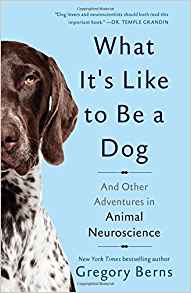By Gregory Berns
From the title, I first expected this to be a story told from a dog’s point of view, but it’s not.  Read the subtitle, “Animal Neuroscience.” This book is about studying dog brains and other animals with MRI scanners. This allowed researchers to measure the strength of connections within the brain.
Read the subtitle, “Animal Neuroscience.” This book is about studying dog brains and other animals with MRI scanners. This allowed researchers to measure the strength of connections within the brain.
This book was very interesting, although a bit challenging. Diagrams of the various animal brains would make these studies easier to understand. But Berns discusses brain terminology in a very easy to understand. I found his stories of how he trained dogs to stay inside an MRI without moving fascinating.
Animal Projects
The Dog Project
Dogs were never anaesthetized. They learned to rest their chin on a bar and stay still while the MRI made studied their brains. Berns also taught the dogs to touch a target with their nose while inside the MRI. He also tested their reactions to different images or objects and seeing their owner. Although he measured their brain activity during these tests, was it thinking?
https://www.youtube.com/watch?time_continue=134&v=eVw1zs2X3iA
Berns also studied how dogs learned the names of toys. Another study involved dogs preferred method of reward, food or praise. Some studies did not involve MRI scans. But many tried to find their thought processes and motivation.
One of the unique characteristics of the Dog Project was their concern about the dog’s welfare. The project did not harm or restrain the dogs and allowed the dog’s a choice on if they wanted to enter the MRI that day.
Berns says he gave the dogs a choice because of his medical school training. Decades ago, I was a technician at a medical school where I had to help during the dog physiology lab. Bern’s experience was exactly like mine, similar setup, tests, and surgery on a live animal. At least I was not involved in killing the dog at the end of the lab, as he was. He wished he had boycotted the lab, and over the years, many students did. The professors said that the dogs were from a pound and would die anyway. And wasn’t it better for medical students to practice on a dog before they work on a person? This line of thinking has changed over the years, and now these labs only involve simulations.
Other Animals
One of the studies that I especially liked involved sea lions. Fish that ate the phytoplankton Pseudo-nitzschia would have high levels of domoic acid. Sea lions that ate these fish bio-accumulated domoic acid. High levels of domoic acid in sea lions affected their memory of where to find food. The sea lions then either starved or had seizures from the high doses of domoic acid. MRIs showed similar patterns for sea lions that had seizures as humans with epilepsy.
Another study involved Ronan, a sea lion that learned to grove to musical beats. He bobbed his head the way humans tap their feet to a musical.
Other studies involved studying the brains of living, dead, and extinct animals. These included dolphins, Tasmanian devils, and the extinct thylacine.
Conclusions
The last chapter was the most interesting. Here Berns discusses the legalities of pain experienced by animals. In the U.S., there is no ban on pain and researchers only need to categorize the level of pain in dogs but not rats or mice.
Studies have shown that many, if not most animals, are sentient beings. They are aware of their internal states, and show self-awareness, like people. Dogs may one day have rights as sentient beings and no longer considered as property. In November of 2013, a divorce case contested the ownership of a dog. The judge decided to hold a custody hearing for the dog, but the couple settled and the hearing didn’t occur. It’s unique that a judge would even think to hold a custody hearing for a pet.
Berns favors the idea of animal advocates to argue cases in favor of the animal’s interest. Although the court still views animals as property, that way of thinking is changing. Neuroscience will help us understand animals better and may assist in their advocacy.
I rate this book as a 4.5 out of 5 stars.
This is a Wordless Wednesday blog hop. Please comment on mine and other posts.


What a fascinating book. I definitely believe animals are sentient beings and enjoy reading research like this about neuroscience. So relieved he does not harm the dogs participating in his studies now. Hopefully advocacy and respect will grow with education.
I agree with Debbie, so happy that they use positive reinforcement for this stuff. Very interesting book, I definitely want to give it a read.
What an interesting post. I love the idea of animals someday becoming sentient beings for all purposes — most animals I know are more aware of their feelings than people sadly. We need to work harder as a community to make this change happen. Love seeing this type of testing being done so we can see and learn more about how our dogs think.
This book sounds so interesting. I have heard snippets about his studies, but may have to add this book to my Christmas WishList!
This looks like a fantastic book. I attended a talk by an animal rights advocate this year and was heartened to hear that this movement is gaining ground – however slowly.
Interesting post. I was wondering if you were going to mention harm to animals and you did. It’s awful some of the things that animals are forced to go through. I was happy to read that some of this is changing in science. Yes I believe dogs (and cats) can be trained without harm and still be able to study the brain or behaviors. I don’t need science or a degree to know they are sentimental beings…they are all selfless loving beings. 🙂